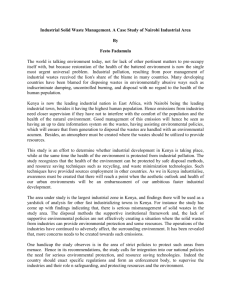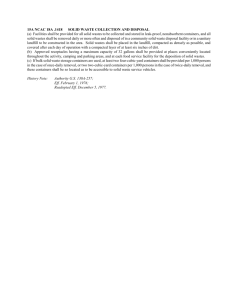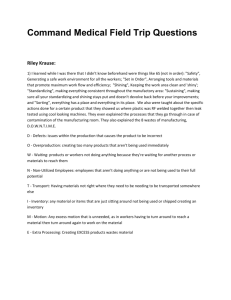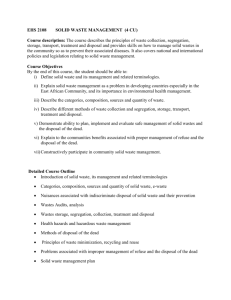Waste Management - Environmental Protection Department
advertisement
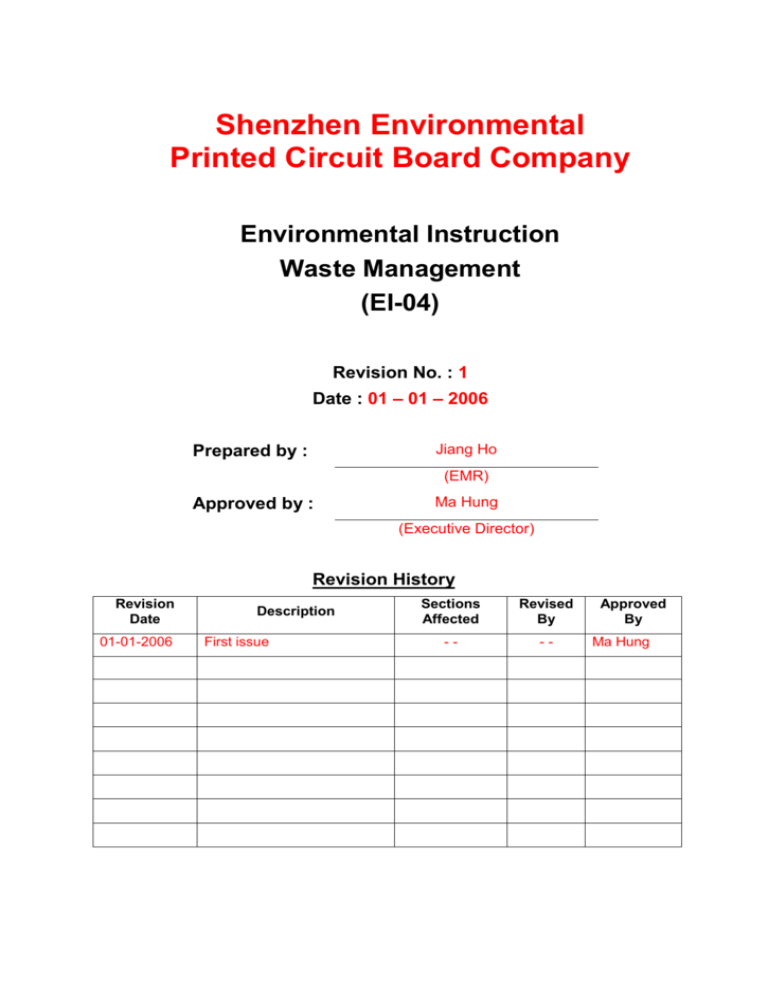
Shenzhen Environmental Printed Circuit Board Company Environmental Instruction Waste Management (EI-04) Revision No. : 1 Date : 01 – 01 – 2006 Jiang Ho Prepared by : (EMR) Approved by : Ma Hung (Executive Director) Revision History Revision Date 01-01-2006 Description First issue Sections Affected Revised By -- -- Approved By Ma Hung Waste Management SZEPCB 1.0 Instruction Number : EI-04 Revision Number: 1 Date:01-01-2006 Purpose This instruction outlines the practices to be adopted to control the production, storage and disposal of wastes in order to fulfil the legal and other requirements. 2.0 Scope This instruction is applicable to the management of solid wastes in both Hong Kong and Shenzhen office located at confined area. Some solid wastes producing from the office activities and the plant include: General refuse from office activities (Hong Kong and Shenzhen) (e.g. paper wastes, spent toner cartridge, etc.); General refuse from the plant (e.g. air filters, demolished machinery and parts, PCB scraps, rejected products and spent laminate sheets, etc.); Pantry / canteen wastes (e.g. food wastes, spent tableware and lunch boxes, etc.); Packaging wastes (e.g. packaging materials for food, paper strips, plastic strips and carton box, cardboard and wooden planks, etc.); Metal waste (e.g. used copper foil and sheet, tin bar / sheet, aluminium cans, steel cans, etc.); Some chemical wastes producing from the plant includes: Spent empty chemicals containers, spent lubricant / hydraulic oil from general production process, spent heavy metal during the drilling process; Radiation emitted from X-ray drilling process; Pumice wastes from dry film imaging and soldermask; Spent etchant and chemical sludge from etching process; Spent nickel sulphate and zinc chloride during the nickel plating process; Spent chemical wastes from chemical laboratory such as chemical indicators, oxidizing agents, acidic and alkaline. 3.0 Procedure 3.1 Classification of Wastes 3.1.1 Recyclable Wastes: Used copper foil and sheet, tin bar / sheet, aluminium cans, steel cans, etc. General Refuses Wastes: Food wastes, lunch boxes, used tableware from factory canteen, packaging materials, etc. Chemical Wastes: Chemical wastes producing from the plant and chemical laboratory. 3.2 Storage and Labelling of Wastes 3.2.1 Storage and labelling of chemical wastes 3.2.1.1 Production Manager and responsible departments shall prepare Chemical Waste Page 2 Waste Management SZEPCB Instruction Number : EI-04 Revision Number: 1 Date:01-01-2006 Checklist and approved by EMR. Chemical Waste Checklist shall be reviewed at least once a year. When new legal requirements about wastes are updated, Production Manager shall update accordingly. 3.2.1.2 For the containers of chemicals, use water to clean up the containers and place to the designated area for contractor to collect them. Ensure the wastewater to be discharged properly. 3.2.1.3 Chemical wastes shall be packed with red waste bags or dedicated containers and clearly labelled with the waste name. 3.2.1.4 For storage of chemical wastes at the designated area, it shall be segregated properly to prevent happening of leakage, spillage, fire, explosion, etc. 3.2.2 Storage and Labelling of General Refuse 3.2.2.1 3.3 Wastes segregation at workplace shall be conducted accordingly to below listed. Clear labelling and category storage description shall be placed at the designated wastes collection area. Waste bags and waste containers shall be reused properly. Papers White waste bags General refuses Black waste bags Plastics Blue waste bags Chemicals and toxic substances Red waste bags Waste Disposal 3.3.1 Waste collector shall maintain relevant operation license. 3.3.2 The appointed waste collector shall implement environmental control based upon the EI-02 Green Procurement. 3.3.3 Administration Department is responsible for monitoring the quantity of waste and making analysis according to the principle of waste reduction. Waste Disposal Monthly Report (EF-EI04-01) shall be completed by Administration Department as well by the end of each month, and kept for at least 1 year. 3.4 Emergency Situation 3.4.1 When leakage, fire or explosion of stored chemical wastes is happened in the plant, the responsible departments shall follow EP-05 Environmental Emergency Preparedness and Response. 4.0 Monitoring and Checking 4.1 The responsible departments shall follow EP-06 Environmental Monitoring and Evaluation of Compliance to inspect the waste disposal activities. When NC are identified, the EMR shall ensure that corrective action shall be defined and implemented in accordance with EP-07 Enquiry / Complaint / Nonconformity Handling. 5.0 Records Page 3 Waste Management SZEPCB Retention Responsibility Minimum Retention Time Waste Disposal checklist (Refer to related waste disposal records) Production Manager 3 years Chemical Waste Checklist (Refer to related chemical waste records) Production Manager 3 years Production Manager / 3 years Record Description Workplace Environmental Inspection Report (If find any nonconformity items, EFEP07-01 can be referred) Waste Disposal Monthly Report EF-EI04-01 6.0 Record Location / Instruction Number : EI-04 Revision Number: 1 Date:01-01-2006 Engineering Department Production Manager Appendix Appendix 1 : Waste Disposal Monthly Report (EF-EI04-01) Page 4 3 years SZEPCB Date Waste Disposal Monthly Report Type of Waste EI-04 Appendix 1 Waste quantity Waste disposal method Page 5 Form Number : EF-EI04-01 Revision Number: 1 Date:01-01-2006 Responsible Department

